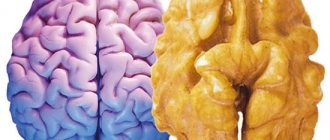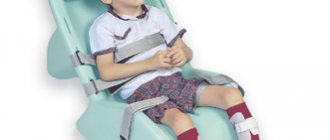International magazine
The development of a child with intellectual disabilities from the first days of life differs from the norm. In many children, the appearance of erect standing is delayed, i.e. They begin to hold their head up, sit, stand, and walk much later. This delay is sometimes quite significant, extending into the second year of life [1].
Let us consider the developmental features of a child with intellectual disabilities in the following age periods: infant, early, preschool and school age.
Infancy. All children with intellectual disabilities have a reduced reaction to external stimuli, indifference, and general pathological inertia (which does not exclude loudness, anxiety, irritability, etc.). They do not have a need for emotional communication with adults; as a rule, there is no “revival complex,” while a normally developing child, in response to an adult’s voice or smile, throws up his arms and legs, smiles, and hums quietly [2].
In the future, children with intellectual disabilities do not develop interest in toys hung above the crib or in the hands of an adult. There is no timely transition to communication with adults based on joint actions with toys, and a new form of communication—gesture—does not arise. Children in the first year of life do not differentiate between “their” and “strangers” adults, although with normal development this is observed already in the first half of life [3].
Children with intellectual disabilities do not have active grasping, they do not develop visual-motor coordination and perception of the properties of objects (large and small objects; normally developing children grasp differently, depending on the shape), as well as the selection of objects from a number of others [4].
In these children, the prerequisites for speech development are not formed in a timely manner: objective perception and objective actions, emotional communication with adults and, in particular, pre-speech means of communication (facial expressions, pointing gestures).
The developmental influence of an adult, in many cases, is not carried out, and the zone of proximal development does not expand. The sensitive period for the formation of many physical capabilities and mental processes has been missed [5].
Early age (from 1 year to 3 years). For many children with intellectual disabilities, learning to walk is delayed for a long time, sometimes until the end of early childhood. When moving, instability, clumsiness of gait, slowness or impulsiveness of movements are observed [6].
With the development of walking, a new stage in development begins, and the rapid development of objective actions begins.
Not every child’s action with an object is an objective action. An object action is only an action when an object is used in accordance with its functional purpose. So, for example, if a child picks up a spoon and knocks on the table with it, this is not an objective action, but manipulation with an object, since the function of the spoon is different; objective, the action will be when the child uses a spoon to eat [7].
Development of subject activity.
In young children with intellectual disabilities, object-based activity is not developed. Some of them show no interest in objects, including toys. They do not pick up toys at all or manipulate them. They do not only have an orientation like “What can you do with this?”, but also a simpler orientation like “What is this?” In other cases, children of the third year of life begin to manipulate objects, which are interspersed with inappropriate actions [8].
Inappropriate actions are those actions that contradict the logic of using an object and come into conflict with the role of the object in the objective world. For example, when a child first puts a cap on the stem of a pyramid and then tries to string rings; knocks the doll on the table; trying to fit a large car into a small garage, etc. - this means he is committing inappropriate actions. In this case, there is no cognitive-orienting activity and these actions do not contribute to the development of the child. The presence of inappropriate actions is a characteristic feature of a child with intellectual disabilities [9].
Other types of children’s activities do not develop independently either—playing, drawing, the beginnings of work activity, which, with normal intelligence, develop by the end of the third year of life [10].
Development of speech and communication.
Children with intellectual disabilities at an early age do not have the necessary prerequisites for the formation of speech: actions with objects, emotional communication with adults, readiness of the articulatory apparatus and phonemic hearing. For most children with intellectual disabilities, the first words in active speech appear after two years. The phrase, as a rule, does not appear until the age of three [11].
The main thing is that the speech of a young child with intellectual disabilities cannot serve either as a means of communication or as a means of conveying social experience to the child. She also cannot assume the function of regulating his actions [8].
Preschool age. Preschoolers with intellectual disabilities do not develop play, work, productive activities, as well as communication as they should at this age. This is due to the immaturity or insufficient development of mental processes: attention, perception, memory, thinking.
Thus, the leading play activity for preschool children is at the initial stage of development by the end of preschool age. In children, only object-based play and procedural actions are observed. They are characterized by repeated, stereotypical repetition of the same actions, carried out without emotional reactions, without the use of speech (L.B. Baryaeva, A.P. Zarin, N.D. Sokolova, O.P. Gavrilushkina) [9] .
Children with intellectual disabilities master self-care skills at a later date than their typically developing peers.
Without special training, they do not develop productive activities - drawing, modeling, appliqué, design.
In the cognitive sphere, attention disorders come to the fore: children’s attention is difficult to gather, they cannot concentrate on completing a task, they have increased distractibility and absent-mindedness. Preschoolers with intellectual disabilities are attracted to bright, colorful objects and toys, but they quickly lose interest in them [2].
At this age, memory impairments appear. It is especially difficult for them to remember instructions that determine the sequence of actions.
The leading form of thinking in preschoolers with intellectual disabilities is visual-effective thinking, although it does not reach the same level of development as in normally developing children. By the end of preschool age, children with intellectual problems who do not receive special correctional assistance “virtually lack the ability to solve visual-figurative problems” [10].
We can say that by the end of preschool childhood, children with intellectual development problems who have not undergone special training lack readiness for educational activities. Disturbances in mental development that are not corrected in a timely manner are aggravated, becoming more pronounced and vivid [11].
School age. The leading activity of school-age children is educational, which has a number of features for children with problems of intellectual development.
In physical development, children with intellectual disabilities lag behind their normally developing peers. It is quite difficult for schoolchildren with intellectual disabilities to maintain a working posture throughout the entire lesson; they get tired quickly. Children's performance in the classroom is reduced [12].
Attention in children with intellectual disabilities is characterized by a number of features: the difficulty of attracting it, the impossibility of long-term active concentration, quick and easy distractibility, instability, absent-mindedness, low volume (I.L. Baskakova, S.V. Liepin, M.P. Feofanov, etc. .). A student with an intellectual disability may pretend to be an attentive student in class, but at the same time not hear the teacher’s explanations at all. In order to combat this phenomenon (pseudo-attention), the teacher, during the explanation, should ask questions that reveal whether the students are following his train of thought, or offer to repeat what was just said [7].
Perception in children with intellectual disabilities is also characterized by a number of features. Their perception speed is noticeably reduced. In order to learn an object or phenomenon, schoolchildren with intellectual disabilities need more time compared to their normally developing peers (K.I. Veresotskaya). This feature is important to take into account in the educational process: the teacher’s speech should be slow so that students have time to understand it, it is necessary to give more time to look at objects, paintings, and illustrations [13].
Schoolchildren with intellectual disabilities have a reduced volume of perception, that is, the simultaneous perception of a group of objects. The narrowness of perception makes it difficult for students to master reading, calculations with multi-digit numbers, etc.
In children with insufficient intelligence, spatial perception and spatial orientation are significantly impaired, which makes it difficult for them to master such academic subjects as mathematics, geography, history, etc. [5].
The perception of paintings presents great difficulties for them (K.I. Veresotskaya, I.M. Solovyov, N.M. Stadnenko). They, as a rule, do not see connections between characters, do not understand cause-and-effect relationships, do not understand the emotional states of the characters depicted, do not see the plot, do not understand the depiction of movement, etc.
Children with intellectual disabilities have speech development disorders. In this case, all components of speech suffer: vocabulary, grammatical structure, sound pronunciation. By the time they start school, they have a limited vocabulary that consists mainly of nouns and verbs.
Impaired ability of thought processes - analysis, synthesis, abstraction, comparison. The thinking of children with intellectual disabilities is characterized by inertia and stiffness [14].
DEVELOPMENTAL FEATURES OF CHILDREN WITH INTELLECTUAL DISABILITIES
DEVELOPMENTAL FEATURES OF CHILDREN WITH INTELLECTUAL DISABILITIES
Annotation. The article highlights the main age period and features of the development of a child with intellectual disabilities at school age. The level of formation of higher mental functions in children with problems of intellectual development is considered: attention, perception, thinking, memory, speech.
Key words: development, age, intelligence, speech, attention, perception, thinking, memory.
Mental retardation, which negatively affects the mental development of a small person, is diagnosed both in childhood and adolescence, if the degree of brain damage is insignificant.
In especially severe cases, it becomes possible to make a diagnosis already in the first months after the birth of the child. But most often, adults notice the problem after the baby enters kindergarten or school.
About 85% of children with intellectual disabilities suffer from mild mental retardation. Experts make a diagnosis only after the child enters first grade.
Typically, intellectual impairment in elementary school students is manifested by the inability to learn material and behavior that differs from peers.
Types of mental retardation
There are several types of mental retardation, each of which has its own signs and behavioral characteristics:
- mild mental retardation;
- moderate;
- heavy;
- deep.
Children with mental retardation easily find contact with peers and cope with the school curriculum, although they have some problems with assimilation of information. Growing up, such people can become full-fledged members of society, able to occupy certain positions and provide for themselves and their families, but this is possible only after receiving the help they need.
Learning difficulties
Children with intellectual disabilities not only have difficulty finding contact with others, especially with peers, but they also have certain difficulties in learning. Depending on the degree of brain damage, some of them can study in a regular high school, mastering, albeit with difficulty, the general education curriculum. The physical development of such children does not differ from the norm, and visually they look quite healthy. Other children with more severe intellectual disabilities may not be able to master the high school curriculum, so they study in specialized institutions. A child with a mild intellectual disability can study in a regular school with proper participation of parents and teachers in his school life.
If mental abilities are severely impaired, then studying in a regular school can be associated with isolation, failure, and disappointment.
Children with severe intellectual disabilities will be properly educated in schools where trained specialists in corrective techniques will work with them.
Let's consider the developmental features of a child with developmental disorders: school age.
The leading activity of school-age children is educational, which has a number of features for children with problems of intellectual development.
In physical development, children with intellectual disabilities lag behind their normally developing peers. It is quite difficult for schoolchildren with intellectual disabilities to maintain a working posture throughout the entire lesson; they get tired quickly. Children's performance in the classroom is reduced.
Attention in children with intellectual disabilities is characterized by a number of features: the difficulty of attracting it, the impossibility of long-term active concentration, quick and easy distractibility, instability, absent-mindedness, low volume. A student with intellectual disabilities in a lesson can pretend to be an attentive student, but at the same time completely fail to hear the teacher’s explanations. In order to combat this phenomenon (pseudo-attention), the teacher, during the explanation, should ask questions that reveal whether the students are following his train of thought, or offer to repeat what was just said.
Perception in children with intellectual disabilities is also characterized by a number of features. Their perception speed is noticeably reduced. In order to learn an object or phenomenon, schoolchildren with intellectual disabilities require more time compared to their typically developing peers. This feature is important to take into account in the educational process: the teacher’s speech must be slow so that students have time to understand it; more time must be given to look at objects, paintings, and illustrations.
Schoolchildren with intellectual disabilities have a reduced volume of perception, that is, the simultaneous perception of a group of objects. The narrowness of perception makes it difficult for students to master reading, calculations with multi-digit numbers, etc.
In children with insufficient intelligence, spatial perception and spatial orientation are significantly impaired, which makes it difficult for them to master such academic subjects as mathematics, geography, history, etc.
Perceiving pictures poses great difficulties for them. They, as a rule, do not see connections between characters, do not understand cause-and-effect relationships, do not understand the emotional states of the characters depicted, do not see the plot, do not understand the depiction of movement, etc.
Children with intellectual disabilities have speech development disorders. In this case, all components of speech suffer: vocabulary, grammatical structure, sound pronunciation. By the time they start school, they have a limited vocabulary that consists mainly of nouns and verbs.
Impaired ability of thought processes - analysis, synthesis, abstraction, comparison. The thinking of children with intellectual disabilities is characterized by inertia and stiffness.
Self-esteem
Children with impaired functioning of the intellect have insufficiently formed mental operations, which results in the manifestation of one significant feature: they do not know how to adequately assess themselves and their capabilities. As a rule, these children are always happy with what they do and are not aware of failures.
To speed up the socialization of such children, they need to be engaged in occupational therapy. We are talking about simple work in the country, on a farm, in a pottery workshop, for example, or in a stable caring for horses. Contact with animals, both horses and pets, has a positive effect on the development of children, who begin to feel their importance and necessity, completely adopting the behavior of adults.
It is believed that children with this diagnosis socialize faster, spending a lot of time in the country or in the village, where they will have constant responsibilities and tasks that will need to be completed under the supervision of an adult. In the course of such work, children will be able to improve their motor skills, learn to build connections with others, and be able to develop as individuals and become part of society.
Is it possible to cure intellectual disabilities?
Unfortunately, the disease will remain with the child for life. However, it should be noted that this is a stable condition that can only change in adolescence and adulthood, depending on the degree of impairment.
If children are provided with specialized education with corrective education, then in cases with mild mental retardation they will be able to feel confident enough to integrate into social life.
Bibliography
1. Fundamentals of oligophrenopedagogy: textbook. aid for students avg. textbook institutions / V.M. Mozgovoy, I.M. Yakovleva, A.A. Eremina. - M.: Publishing House, 2006. - 224 p.
2.Teaching children with mental retardation: a manual for teachers T.A. Vlasov, V.I. Lubovsky. Moscow enlightenment 2015
4. Special psychology / ed. IN AND. Lubovsky. -2nd ed., rev. - M.: Publishing House, 2005.
5. Correction of ideas about the surrounding world in children with intellectual disabilities./ A.N. Kosymova.// Defectology. -2006. - No. 5.









